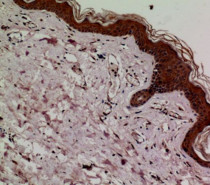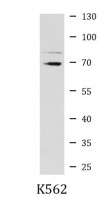ARG66711
anti-KEAP1 antibody
anti-KEAP1 antibody for IHC-Formalin-fixed paraffin-embedded sections,Western blot and Human,Mouse,Rat
Overview
| Product Description | Rabbit Polyclonal antibody recognizes KEAP1 |
|---|---|
| Tested Reactivity | Hu, Ms, Rat |
| Tested Application | IHC-P, WB |
| Host | Rabbit |
| Clonality | Polyclonal |
| Isotype | IgG |
| Target Name | KEAP1 |
| Antigen Species | Human |
| Immunogen | Synthetic peptide within aa. 411-460 of Human KEAP1. |
| Conjugation | Un-conjugated |
| Alternate Names | KLHL19; Cytosolic inhibitor of Nrf2; INrf2; Kelch-like protein 19; Kelch-like ECH-associated protein 1 |
Application Instructions
| Application Suggestion |
|
||||||
|---|---|---|---|---|---|---|---|
| Application Note | * The dilutions indicate recommended starting dilutions and the optimal dilutions or concentrations should be determined by the scientist. | ||||||
| Positive Control | K562 | ||||||
| Observed Size | ~ 70 kDa |
Properties
| Form | Liquid |
|---|---|
| Purification | Affinity purification with immunogen. |
| Buffer | PBS, 0.02% Sodium azide, 50% Glycerol and 0.5% BSA. |
| Preservative | 0.02% Sodium azide |
| Stabilizer | 50% Glycerol and 0.5% BSA |
| Storage Instruction | For continuous use, store undiluted antibody at 2-8°C for up to a week. For long-term storage, aliquot and store at -20°C. Storage in frost free freezers is not recommended. Avoid repeated freeze/thaw cycles. Suggest spin the vial prior to opening. The antibody solution should be gently mixed before use. |
| Note | For laboratory research only, not for drug, diagnostic or other use. |
Bioinformation
| Database Links |
Swiss-port # Q14145 Human Kelch-like ECH-associated protein 1 Swiss-port # Q9Z2X8 Mouse Kelch-like ECH-associated protein 1 |
|---|---|
| Gene Symbol | KEAP1 |
| Gene Full Name | kelch-like ECH-associated protein 1 |
| Background | This gene encodes a protein containing KELCH-1 like domains, as well as a BTB/POZ domain. Kelch-like ECH-associated protein 1 interacts with NF-E2-related factor 2 in a redox-sensitive manner and the dissociation of the proteins in the cytoplasm is followed by transportation of NF-E2-related factor 2 to the nucleus. This interaction results in the expression of the catalytic subunit of gamma-glutamylcysteine synthetase. Two alternatively spliced transcript variants encoding the same isoform have been found for this gene. [provided by RefSeq, Jul 2008] |
| Function | Acts as a substrate adapter protein for the E3 ubiquitin ligase complex formed by CUL3 and RBX1 and targets NFE2L2/NRF2 for ubiquitination and degradation by the proteasome, thus resulting in the suppression of its transcriptional activity and the repression of antioxidant response element-mediated detoxifying enzyme gene expression. Retains NFE2L2/NRF2 and may also retain BPTF in the cytosol. Targets PGAM5 for ubiquitination and degradation by the proteasome. [UniProt] |
| Cellular Localization | Cytoplasm. Nucleus. Note=Shuttles between cytoplasm and nucleus. [UniProt] |
| Highlight | Related products: KEAP1 antibodies; KEAP1 Duos / Panels; Anti-Rabbit IgG secondary antibodies; Related news: Keap1-Nrf2-ARE antibody panel is launched |
| Calculated MW | 70 kDa |
| PTM | Ubiquitinated by the E3 ubiquitin ligase complex formed by CUL3 and RBX1 and is subject to proteasomal-independent degradation. Quinone-induced oxidative stress, but not sulforaphane, increases its ubiquitination. Ubiquitination and subsequent degradation is most pronounced following prolonged exposure of cells to oxidative stress, particularly in glutathione-deficient cells that are highly susceptible to oxidative stress. [UniProt] |
Images (2) Click the Picture to Zoom In









